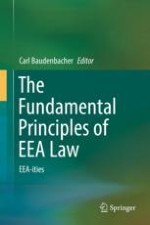2017 | OriginalPaper | Buchkapitel
Proportionality as a Fundamental Principle of EEA Law
verfasst von : Carl Baudenbacher, Theresa Haas
Erschienen in: The Fundamental Principles of EEA Law
Aktivieren Sie unsere intelligente Suche, um passende Fachinhalte oder Patente zu finden.
Wählen Sie Textabschnitte aus um mit Künstlicher Intelligenz passenden Patente zu finden. powered by
Markieren Sie Textabschnitte, um KI-gestützt weitere passende Inhalte zu finden. powered by
